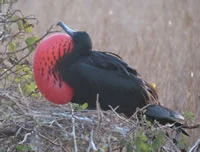by Ian Worley
The amazing irruption of Snowy Owls in North America in this winter of 2013-2014 has brought these charismatic Arctic wonders to a number of locations in Vermont. Little did we know when a single owl arrived at Perkins Pier on the Burlington waterfront on November 23rd, that we would have a flood of owls and the chance to see several in a day here in Vermont.
Perhaps because the sprawling, flat, clayplain agricultural lands of western Addison County resemble the owls' summer Arctic breeding grounds, an aggregation of snowies soon built and has remained resident into the second half of February.
On February 16th, 2014, a fabulous winter Sunday, over 40 volunteer observers in teams and as individuals spent a few hours or from sunrise to sunset attempting to chronicle all the owls that could be found in Addison County. While the renowned Snowy Owl at the Dead Creek WMA goose viewing area attended to passersby and owlers alike throughout the day, the owlers spread out and canvassed parts or all of 15 towns. Snowy Owls are characteristically quiet during the day and often in easy view, aiding the survey count.
Many of the birds located were at sites where they were known for many days and weeks, perhaps since December. A few new locations were found, as well. In order to help assure that the number of birds counted did not include the same bird twice, observers were sent to the known owl locations throughout the day. For the most part, this technique appears to have worked well. In the densest owl population of western Bridport, it was challenging to know in a few places exactly how many birds there were.
A total of 123 observations of Snowy Owls were made by the observers. These were carefully mapped along with the time of day seen. From that information we concluded that at least 24 individual birds were tallied. There was speculation that more owls would be discovered due to the concentration of birders, but such was not the case. In fact the area of birds was quite constrained, even though through this winter birds have been seen far beyond this area. However the total number is similar to counts of previous weeks. A map of the blitz-found birds can be found at:
https://mapsengine.google.com/map/edit?mid=zIeM49kV5yLs.kVOVmUBkO3Yw
We found Snowy Owls in only four adjacent towns on Sunday – three owls in Panton, six in Addison, twelve in Bridport, and three in Shoreham. The heart of the distribution, “Owl-Alley” if you will, follows Basin Harbor Road and Jersey Street from Shoreham to Panton. It was possible to see 10+ owls in less than an hour if you were familiar with their locations.
The northernmost location was on Slang Road in Panton, the easternmost were three owls scattered at locations along or near Route 22A, and the southernmost were two birds in northern Shoreham near the corner of Basin Harbor Road and North Cream Hill Road. None were on the frozen Lake Champlain shoreline. Thus the area with birds is but 18 miles from north to south, and 3-5 miles wide.
We can thank the late stages of glaciation for this special topography. Large Lake Vermont, dammed by a glacier just to the north 10,000 years ago deposited extensive glacial-ground clays at its bottom creating today’s flat clayplain landscape of along Lake Champlain, which itself is a remnant of Lake Vermont. Over 200 years of farming have created the large open fields and the prey found at their margins and within.
Four day-long surveys by four different birders between February 6th and 12th yielded 23 Snowy Owls. Three of those birds were farther north, one each in Panton, Ferrisburgh, and Starksboro. Slightly over half of the birds seen in those weeks were seen in the same locations as birds seen during the blitz on February 16th. It would seem that while the general location of the birds has stayed pretty much the same through this month, some birds have repositioned. Perhaps that is because of food availability, social interactions, boredom, or who knows what ……
In some places the owls roost during the day well spaced from other owls, but a few territorial encounters have been observed. However, in other places it is possible to see two individuals quite close to each other. Where they spend the night seeking prey is unknown.
How long will they stay now that the days are lengthening rapidly and the temperatures will soon rise? Not long, you would expect. That duration will be discovered by those of you who seek or chance to see a Snowy Owl in the next days and perhaps weeks.
Many thanks to all the participants of the Blitz, to those who shared best wishes but could not attend, to those who assisted in the design of the project and the analysis to date, and especially to Ellie George who envisioned the concept and suggested we do it …. only four days prior!




